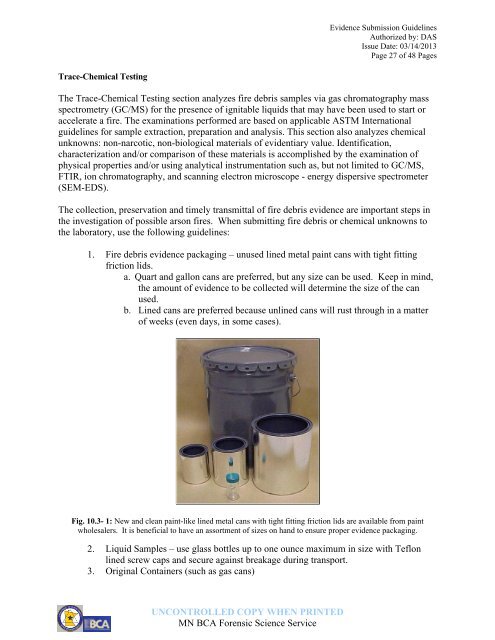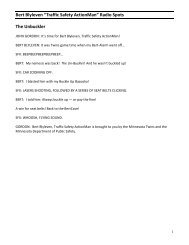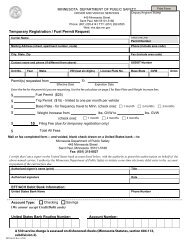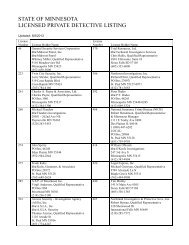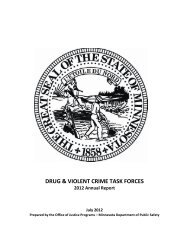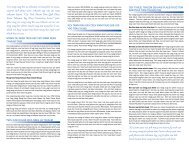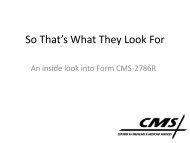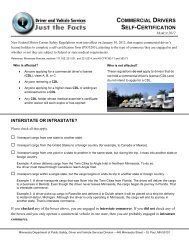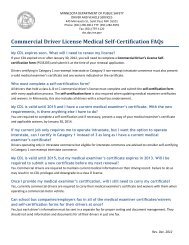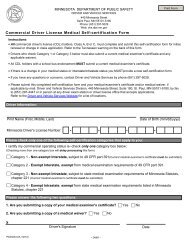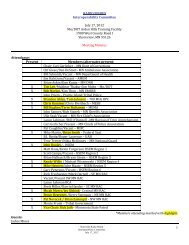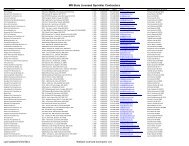Evidence Submission Guidelines - Minnesota Department of Public ...
Evidence Submission Guidelines - Minnesota Department of Public ...
Evidence Submission Guidelines - Minnesota Department of Public ...
Create successful ePaper yourself
Turn your PDF publications into a flip-book with our unique Google optimized e-Paper software.
Trace-Chemical Testing<br />
UNCONTROLLED COPY WHEN PRINTED<br />
MN BCA Forensic Science Service<br />
<strong>Evidence</strong> <strong>Submission</strong> <strong>Guidelines</strong><br />
Authorized by: DAS<br />
Issue Date: 03/14/2013<br />
Page 27 <strong>of</strong> 48 Pages<br />
The Trace-Chemical Testing section analyzes fire debris samples via gas chromatography mass<br />
spectrometry (GC/MS) for the presence <strong>of</strong> ignitable liquids that may have been used to start or<br />
accelerate a fire. The examinations performed are based on applicable ASTM International<br />
guidelines for sample extraction, preparation and analysis. This section also analyzes chemical<br />
unknowns: non-narcotic, non-biological materials <strong>of</strong> evidentiary value. Identification,<br />
characterization and/or comparison <strong>of</strong> these materials is accomplished by the examination <strong>of</strong><br />
physical properties and/or using analytical instrumentation such as, but not limited to GC/MS,<br />
FTIR, ion chromatography, and scanning electron microscope - energy dispersive spectrometer<br />
(SEM-EDS).<br />
The collection, preservation and timely transmittal <strong>of</strong> fire debris evidence are important steps in<br />
the investigation <strong>of</strong> possible arson fires. When submitting fire debris or chemical unknowns to<br />
the laboratory, use the following guidelines:<br />
1. Fire debris evidence packaging – unused lined metal paint cans with tight fitting<br />
friction lids.<br />
a. Quart and gallon cans are preferred, but any size can be used. Keep in mind,<br />
the amount <strong>of</strong> evidence to be collected will determine the size <strong>of</strong> the can<br />
used.<br />
b. Lined cans are preferred because unlined cans will rust through in a matter<br />
<strong>of</strong> weeks (even days, in some cases).<br />
Fig. 10.3- 1: New and clean paint-like lined metal cans with tight fitting friction lids are available from paint<br />
wholesalers. It is beneficial to have an assortment <strong>of</strong> sizes on hand to ensure proper evidence packaging.<br />
2. Liquid Samples – use glass bottles up to one ounce maximum in size with Teflon<br />
lined screw caps and secure against breakage during transport.<br />
3. Original Containers (such as gas cans)


